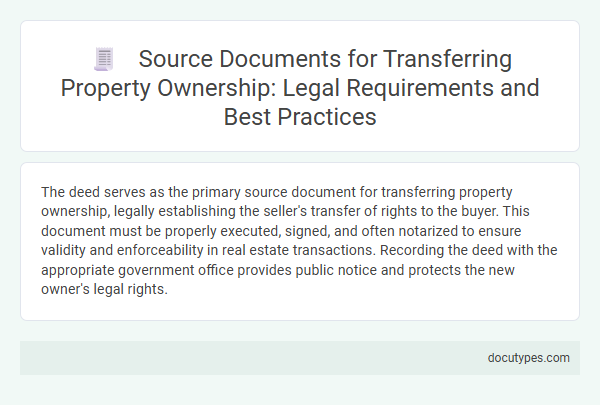The deed serves as the primary source document for transferring property ownership, legally establishing the seller's transfer of rights to the buyer. This document must be properly executed, signed, and often notarized to ensure validity and enforceability in real estate transactions. Recording the deed with the appropriate government office provides public notice and protects the new owner's legal rights.
Introduction to Property Ownership Transfer
Property ownership transfer requires precise legal documentation to ensure the transaction's validity and clarity. The primary source document used is the deed, which formally conveys ownership from the seller to the buyer. Understanding the role of this deed is essential for anyone involved in real estate transactions or property law.
Key Source Documents in Property Transactions
The primary source document used for transferring property ownership is the deed, which legally conveys title from the seller to the buyer. Other critical documents support the transaction and ensure its validity and legality.
- Deed - A legal document that transfers ownership rights of real property from one party to another and must be properly executed and recorded.
- Title Report - A comprehensive report confirming the seller's legal ownership and identifying any liens, encumbrances, or claims on the property.
- Sale Agreement - A contract outlining the terms and conditions agreed upon by the buyer and seller before the property transfer is finalized.
Legal Requirements for Property Transfer Documents
| Source Document | Deed |
|---|---|
| Legal Requirement | Must be a written instrument that clearly conveys ownership rights from the grantor to the grantee |
| Types of Deeds | Warranty Deed, Quitclaim Deed, Special Purpose Deed |
| Essential Elements | Grantor and grantee names, legal description of the property, grantor's signature, delivery and acceptance |
| Recording Requirement | Deeds must be recorded in the county recorder's office to provide public notice and protect Your ownership rights |
| Additional Documents | Title report, property tax clearance, and sometimes affidavits or disclosures depending on jurisdiction |
| Legal Compliance | Must comply with state laws governing property transfers to be valid and enforceable |
Deed Types and Their Legal Implications
The primary source document used for transferring property ownership is the deed, a legal instrument that conveys title from the seller to the buyer. Different deed types, such as warranty deeds, quitclaim deeds, and grant deeds, serve distinct legal purposes in property transfers.
Warranty deeds provide the highest level of protection, guaranteeing clear title and defending against future claims. Quitclaim deeds transfer ownership without warranties, often used in intra-family transfers or clearing title issues, while grant deeds assure that the property has not been sold to others.
Verification of Title and Ownership
Which source document is used for transferring property ownership? The primary source document for transferring property ownership is the deed. Verification of title and ownership is ensured through a thorough examination of this deed to confirm the seller's legal right to transfer the property.
Notarization and Witnessing: Ensuring Document Validity
The primary source document used for transferring property ownership is the deed. This deed must be properly notarized and witnessed to ensure its legal validity and enforceability.
Notarization confirms the authenticity of the signatures on the deed, preventing fraud during the transfer process. Witnessing involves having unbiased individuals observe the signing, adding a layer of verification. You must ensure these formalities are completed to safeguard the legitimacy of your property transfer.
Common Mistakes in Property Transfer Documentation
Transferring property ownership requires precise documentation to ensure legal validity and avoid future disputes. The primary source document used for this transfer is the deed, which must be accurately prepared and recorded.
Common mistakes in property transfer documentation often lead to delays or legal challenges, impacting the transfer process.
- Incomplete or Incorrect Deed Information - Errors in the deed, such as misspelled names or incorrect property descriptions, can invalidate the transfer.
- Failure to Sign or Notarize Properly - Missing signatures or improper notarization compromise the legal enforceability of the ownership transfer.
- Not Recording the Deed Timely - Delays in recording the deed with the county clerk's office can result in disputes over ownership priority and public record issues.
Record-Keeping and Registration Procedures
The primary source document used for transferring property ownership is the deed. This legal instrument records the transfer of title from the seller to the buyer.
Accurate record-keeping ensures the deed is properly registered with the local land registry office. Your property rights depend on the official registration of this document to validate ownership.
Best Practices for Secure Property Transfers
The primary source document used for transferring property ownership is the deed, which legally conveys title from the seller to the buyer. Best practices for secure property transfers include verifying the deed's authenticity, conducting thorough title searches, and utilizing escrow services to protect all parties involved. Ensuring these steps helps safeguard your investment and prevents fraudulent transactions.
Which Source Document Is Used for Transferring Property Ownership? Infographic

